April 12, 2021
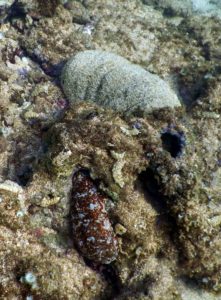
These two species of sea cucumbers are snoozing together on Oahu’s North Shore reef. The small yellowish creatures on the rocks are sap suckers, a type of sea slug. ©Susan Scott
I’ve often thought that sea cucumbers don’t get the respect they deserve, and an Australian research team agrees. In a recent study on Heron Island, a magnificent coral-and-sand island on the Great Barrier Reef, scientists put sea cucumbers on the map. Literally.
The researchers used drones and satellite images to count the number of sea cucumbers lying on the ocean floor around the island. After studying how much sand each sea cucumber ingests per day, the scientists calculated that in one year, the Heron Island cucumbers recycled about 70 tons of sand, a mass of about 5 Eiffel Towers.
That’s a lot of poo. Fortunately, it isn’t your standard kind of poo.
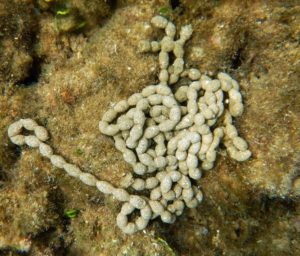
Sea cucumber excrement looks like beads of sand. ©Susan Scott
The world’s sea cucumbers resemble sausages of various colors and sizes, and barely look alive. Most 1,200 or so species of the world rest during the day, and move about slowly at night by extending tiny suction cup tube feet from their undersides, like their starfish and sea urchin cousins.
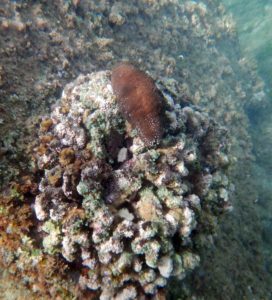
This sea cucumber chose to nap up high. ©Susan Scott
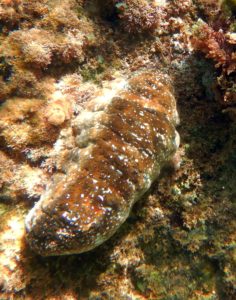
Actinopyga varians, or white-spotted sea cucumber. Waialua, Oahu. ©Susan Scott
Sea cucumbers only have to go as far as their own backyards. These hot dogs of the reef keep the ocean floor clean by sucking sediment in through the mouths, digesting any organic material in it, and pushing out the cleaned sand through their anuses.
In addition to cleaning the ocean floor of decaying matter, vacuuming has other benefits. The action of sucking up sand also stirs it, releasing nitrogen and calcium carbonate trapped among the grains.
Nitrogen is essential to all life on the planet, and calcium carbonate is the stuff of shells. Liberating this mineral is notable in this era of climate change because the ocean’s subsequent acidification dissolves shells. Corals, coralline algae, snails, barnacles, sea urchins, and countless other marine animals need calcium carbonate not only to grow and reproduce, but also to repair damage done by acidic water.
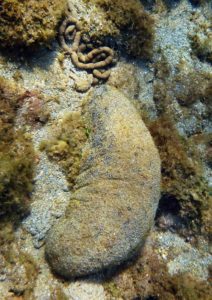
Holuthuria whitmaei, or teated sea cucumber, resting near its beads of sand. ©Susan Scott
Sea cucumbers’ scrubbing and airing of the ocean floor also helps bottom dwelling crabs, worms, and snails by making their underground homes heathier places to live.
Hawaii hosts about 50 sea cucumber species, half in shallow water. Because these animals are so critical to the health of our reefs, sea cucumbers are protected by state law. Limiting the number that can be collected is crucial because the edible species are in demand.
Sea cucumbers tube feet usually hold the animals in place right-side up, but big surf and surge can send the sausage-shaped animals rolling about, and sometimes wash them ashore. If you find one in this predicament, return it to the sea. When I’m snorkeling, I place dislodged sea cucumbers in rocky cracks, holding them there until they get re-anchored.
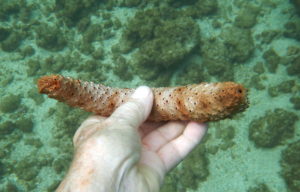
I found this black-spotted sea cucumber, Holothuria dofleinii, tumbling in the surf on Oahu’s North Shore, and found it a secure place to nap. ©Susan Scott
Otherwise, leave them in peace. When threatened, some species eject their internal organs to sidetrack predators. Sea cucumbers can regrow lost guts, but the energy intensive process diverts the animal from its hoovering.
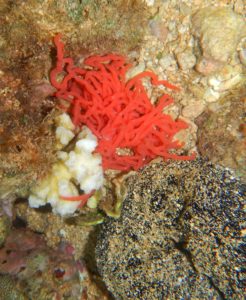
Disturbing sea cucumbers can cause them to eject their insides. I found this animal in this state, not knowing what had threatened it. The red tubules are the animal’s gonads. ©Susan Scott
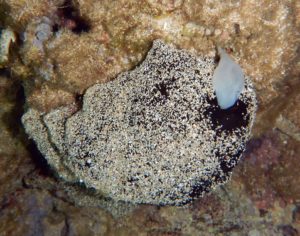
This sea cucumber began ejecting its internal organs during my picture taking. I left it alone. This and the above picture are both Holothuria whitmaei, or teated sea cucumbers, one of the species valued as food. ©Susan Scott
Sea cucumbers may not look as pretty as sea slugs, and aren’t as charming as hermit crabs, but be kind to these quiet sand sifters. We need them.
Published in a subscription-only scientific journal, the Heron Island study is not free to read. It’s explained nicely, however, in a science news article at bit.ly/3us8Qt8 sent by a friend. (Thank you, Martha.)
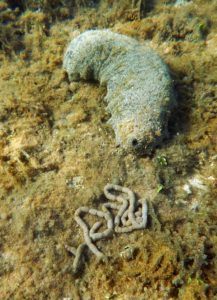
One of Oahu’s excremental heroes. ©Susan Scott